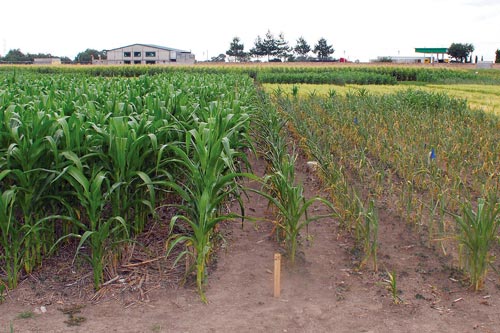By Clare Stirling/CCAFS
A study funded by the Climate Change, Agriculture and Food Security (CCAFS) CRP involving three CIMMYT staff and an international team of scientists has just been published in the journal Nature Climate Change.
The authors of “Limited Potential of No- Till Agriculture for Climate Change Mitigation” conclude that claims relating to no-till agriculture’s role in slowing climate change may be overstated. No-till and reduced tillage are methods of establishing crops with minimum soil disturbance, in contrast to conventional tillage involving plowing or other cultivation practices.
No-till agriculture can deliver benefits in many, though not all, situations; these benefits include improved soil quality and retention of water in soil for use by crops. Therefore the technologies have a clear advantage in dry regions of the world. No-till usually leads to an increase in the concentration of organic matter near the soil surface. This is often interpreted as an absolute accumulation or “locking up” of carbon in soil, termed carbon sequestration; this has led to no-till being promoted as a form of climate change mitigation. This claim was recently restated in the 2013 Emissions Gap Report of the United Nations Environmental Programme (UNEP).

The review found that there was sometimes a genuine, but small, net accumulation of organic carbon in soil under no-till conditions compared with conventional tillage. However, much of the observed effects result from a redistribution of organic carbon with depth – extra organic carbon near the surface but less carbon in deeper soil. In addition, the soil sampling methods normally used tend to exaggerate the effect. Consequently the climate change mitigation achievable from converting to no-till agriculture is likely to be overstated. The authors of the new paper conclude that no-till agriculture has a role to play as one of the strategies contributing to global food security and the protection of soils, and thus to climate change adaptation (through building agricultural systems that are more resilient to climate and weather variability).
In regions where no-till or reduced tillage is agriculturally appropriate it should be promoted on these grounds, but not on the basis of equivocal evidence for climate change mitigation. Climate change mitigation is a small, but useful, additional benefit, not the key policy driver for its adoption. The review also states that those who promote no-till as a means of combating climate change frequently refer to the potential amount of additional carbon that may be stored, or sequestered, in soil. However, in the UNEP report and elsewhere, the barriers to adoption of no-till tend to be ignored.
The authors argue that there are numerous social, practical and infrastructural factors that can make its adoption difficult for farmers, particularly smallholder and resource-poor farmers in developing countries. These issues are being addressed by CIMMYT and others but progress in overcoming the barriers is often slow. Thus, even where there is a real potential for mitigating climate change, it is often difficult to achieve in practice.
Clare Stirling, CIMMYT-CCAFS Project Leader, said, “Overstating the climate change mitigation benefits of no-till is serious because it gives a falsely optimistic message of the potential to reduce climate change through altered agricultural practices.” She added, “Given that the climate change mitigation achievable through adoption of no-till is likely to be far less than claimed, there is even more pressure to decrease greenhouse gas emissions from other agricultural areas. In regard to wheat and maize – the two staple crops CIMMYT focuses on – improved nitrogen management is the key to low-carbon development.”
 Climate adaptation and mitigation
Climate adaptation and mitigation 
